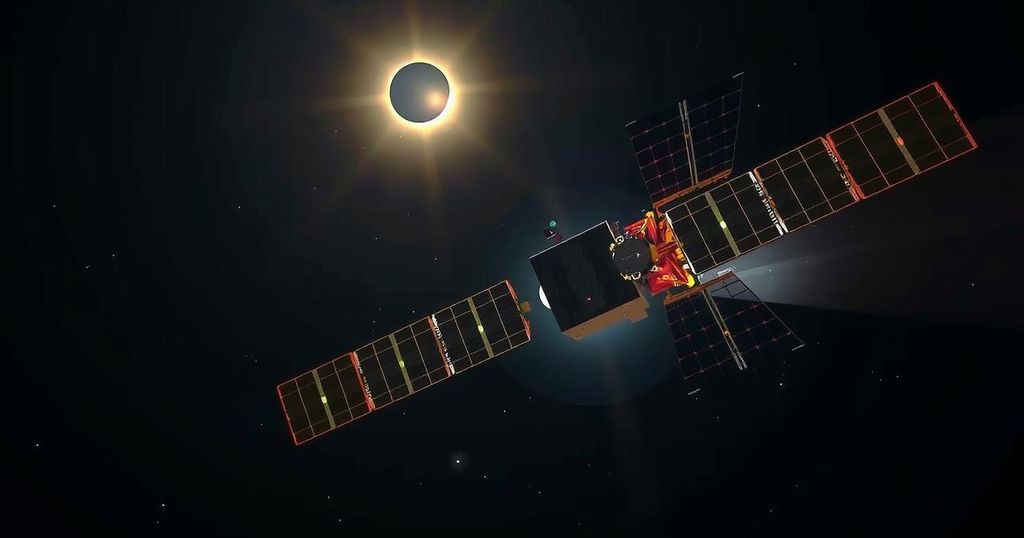ESA’s Proba-3 mission, focused on observing the solar corona via artificial eclipses, has left Europe for its launch in India. After years of development, the spacecraft requires precision maneuvers less than a millimeter apart for successful formation flying. Scheduled for a December 4 launch, this mission represents a significant cooperative effort among multiple countries and marks ESA’s first mission launch from India since 2001.
The cosmos waves goodbye to ESA’s Proba-3 mission, a pioneering endeavor set to explore the elusive solar corona. Recently departing from the European soil of Kruibeke, Belgium, the two spacecraft of Proba-3 now embark on their journey to the launch site at the Satish Dhawan Space Centre in India. This ambitious mission, orchestrated over many years, aims to achieve a feat previously deemed unthinkable in space: creating an artificial solar eclipse. The twin spacecraft will maneuver in perfect harmony as they glide through Earth’s orbit, casting a shadow that will allow them to peer into the distant and faint whispers of the Sun’s atmosphere—the corona—previously only glimpsed during fleeting solar eclipses on Earth. This delicate dance requires an extraordinary level of precision, with the satellites needing to maintain their formation to within a mere millimeter—about the width of a fingernail. Damien Galano, ESA’s mission manager, expressed the mixed feelings that accompany the departure, saying, “There’s a little sadness to finally say goodbye to these unique satellites, but we’re also very excited to be progressing to the final stage before launch.” All systems are set for the launch scheduled on December 4, following delays that pushed the transport to India. Originally held back due to shipping regulations concerning battery installation—an issue resolved by detaching the batteries for safe transport—the craft are now bound for a historic launch from India, marking the first ESA mission to do so since Proba-1’s Earth-observing journey in 2001. Proba-3 will be propelled by the PSLV-XL launcher from the Indian Space Research Organisation, scaling heights of 60,000 km before dipping down to just 600 km to perform critical operations. This lofty trajectory will enable the satellites to effectively engage in formation flying for six hours, minimizing gravitational drag and propellant consumption. An impressive coalition of 14 ESA member states, including collaborations with Canada, has contributed to this mission, led by major players like Sener and Airbus Defence and Space. Proba-3 aims to cultivate scientific understanding through its groundbreaking instruments, including the ASPIICS coronagraph for solar imaging and the DARA for measuring solar energy output, which is vital for understanding climate implications. Mission control will efficiently oversee operations from ESA’s European Space Security and Education Centre in Redu, Belgium, where comprehensive simulations and training are currently being conducted to prepare for the monumental launch. As Proba-3 sets its sights on the cosmos, the commitment of ESA and its partners reflects not only technological achievements but also an unwavering spirit of exploration that defines humanity’s journey into the stars.
The Proba-3 mission stands at the forefront of solar research, combining cutting-edge technology and cooperative international efforts. It seeks to reveal aspects of the Sun’s corona that are typically obscured from our view, utilizing its unique formation flying abilities. By casting shadows in space and enabling continuous observations of the Sun’s atmosphere, Proba-3 aims to fill gaps in our knowledge that can impact both space weather and Earth’s climate. The long history of the ESA’s Proba missions showcases an ongoing commitment to innovation in small satellites designed for specific scientific goals, fostering greater understanding of our solar system.
The farewell to Proba-3 marks not just the departure of sophisticated satellites but a pivotal step towards unlocking the secrets of the solar corona. With their launch on the horizon, these spacecraft symbolize international collaboration and the relentless pursuit of knowledge beyond our world. ESA’s meticulous preparations and advanced technology offer a glimpse into the exciting future of solar research and space exploration.
Original Source: www.esa.int

Leave a Reply